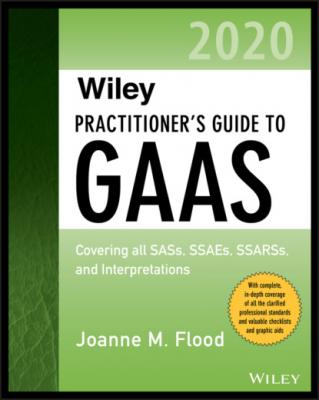Wiley Practitioner's Guide to GAAS 2020. Joanne M. Flood
Читать онлайн.| Название | Wiley Practitioner's Guide to GAAS 2020 |
|---|---|
| Автор произведения | Joanne M. Flood |
| Жанр | Бухучет, налогообложение, аудит |
| Серия | |
| Издательство | Бухучет, налогообложение, аудит |
| Год выпуска | 0 |
| isbn | 9781119596035 |
The size and complexity of the entity
The risk of material misstatement associated with the assertion, or account or class of transactions
The extent of judgment involved in performing the work and evaluating results
The nature of the auditing procedure
The significance of evidence obtained to the tested assertion
The nature and extent of identified exceptions
The need to document a conclusion or basis for a conclusion not readily determinable from the documentation of the work performed
The methodologies or tools used
(AU-C 230.A4)
Documentation of Report Release Date and Revisions
The auditor should document the report release date and complete the assembly of the final audit file on a timely basis, but no later than 60 days following the report release date. (AU-C 230.15–.16) After this date, the auditor must not delete or discard existing audit documentation before the end of the specified retention period, not less than five years from the report release date. If changes are made to the audit documentation after the documentation completion date, the auditor should document when and by whom the changes were made, the specific reasons for the changes, and the effect of the changes, if any, on the auditor’s previous conclusions. (AU-C 230.17 and .18)
Ownership and Confidentiality
The auditor owns the audit documentation, but his or her ownership rights are limited by ethical and legal rules on confidential relationships with clients. The auditor should adopt reasonable procedures to protect the confidentiality of client information. (AU-C 230.19) The auditor should also adopt reasonable procedures to prevent unauthorized access to the audit documentation. Sometimes audit documentation may serve as a source of reference for the client, but it should not be considered a part of, or a substitute for, the client’s accounting records.
Standardization of Audit Documentation
Audit documentation should be designed for the specific engagement; however, audit documentation supporting certain accounting records may be standardized.
The auditor should analyze the nature of his or her clients and the complexity of their accounting systems. This analysis will indicate accounts for which audit documentation may be standardized. An auditor ordinarily may be able to standardize audit documentation for a small-business client as follows:
Cash, including cash on hand
Short-term investments
Trade accounts receivable
Notes receivable
Other receivables
Prepaid expenses
Property, plant, and equipment
Long-term investments
Intangible assets
Deposits
Accrued expenses
Taxes payable
Long-term debt
Stockholders’ equity accounts
Preparation of Audit Documentation
All audit documentation should have certain basic information, such as the following:
1 HeadingName of clientDescription of audit documentation, such as:Proof of cash—Fishkill Bank & Trust CompanyAccounts receivable—confirmation statisticsPeriod covered by engagementFor the year ended …
2 An index numberAll audit documentation should be numbered for easy reference. Audit documentation is identified using various systems, such as the following:AlphabeticalNumbersRoman numeralsGeneral ledger account numbersA combination of the preceding
3 Preparer and reviewer identificationIdentification of person who prepared audit documentation and date of preparation:If the client prepared the audit documentation, this should be noted. Person who checked papers also should be identified.Identification of person who reviewed the audit documentation and date of review.
4 Explanation of symbolsSymbols used in the audit documentation should be explained. Symbols indicate matters such as the following:Columns were footed.Columns were cross-footed.Data were traced to original sources.
5 Source of informationThe audit documentation should indicate source of information:Client recordsClient personnel
Related Accounts
One page of audit documentation may provide documentation for more than one account. Many balance sheet accounts are related to income statement accounts. In these circumstances, the audit work on the accounts should be documented in one page of audit documentation. Examples of related accounts are the following:
Notes receivable and interest income
Depreciable assets, depreciation expense, and accumulated depreciation
Prepaid expenses and the related income statement expenses, such as insurance, interest, and supplies
Long-term debt and interest expense
Deferred income taxes and income tax expense
Client Preparation of Audit Documentation
It is advisable to have the client’s employees prepare as much as possible of the auditor’s audit documentation. This increases the efficiency of the audit. The auditor should identify the audit documentation as “Prepared by the Client” (PBC) and note the auditor who reviewed the client-prepared audit documentation. The preparation of audit documentation by the client does not impair the auditor’s independence. However, the auditor should test the information in client-prepared audit documentation.
Quality of Audit Documentation
Audit documentation aids the execution and supervision of the current year’s engagement. Also, such documentation helps the auditor in planning and executing the following year’s audit. In addition, audit documentation serves as the auditor’s reference for answering questions from the client. For example, a bank or a credit agency may want information that the auditor can provide to the client for submission to the third party from the audit documentation.
In case of litigation against the client, the auditor’s audit documentation may be subpoenaed. In litigation against the auditor, the audit documentation will be used as evidence. Therefore, audit documentation should be accurate, complete, and understandable. After audit documentation is reviewed, additional work, if any, is done, and modifications are made to the audit documentation, superseded drafts, corrected documents, duplicate documents, review notes, and all to-do points should be discarded because the issues they addressed have been appropriately responded to in the audit documentation. (AU-C 230.A6)
Likewise, miscellaneous notes, memoranda, e-mails, and other communications among members of the audit engagement team created during the audit should be included or summarized in the audit documentation when needed to identify issues or support audit conclusions; otherwise, they should be discarded. Any information added after completion of fieldwork should be dated at the date added.
Oral Explanations
